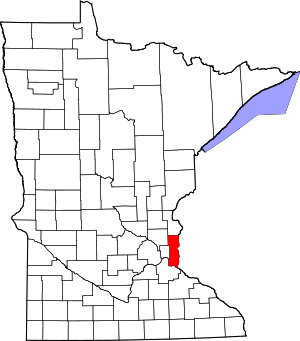Stillwater, Minnesota
Stillwater is a city in Washington County, Minnesota across the St. Croix River from the state of Wisconsin. It is the county seat. The population was 18,225 at the 2010 census.[5][6] Stillwater is part of the Twin Cities Metro Area.
Stillwater | |
|---|---|
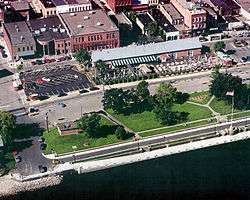 The waterfront of Stillwater on the St. Croix River | |
Seal | |
| Nickname(s): The Birthplace of Minnesota | |
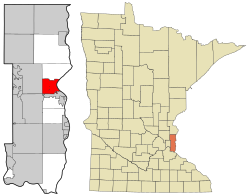 Location of the city of Stillwater within Washington County, Minnesota | |
| Coordinates: 45°3′N 92°49′W | |
| Country | United States |
| State | Minnesota |
| County | Washington |
| Incorporated | March 4, 1854 |
| Government | |
| • Mayor | Ted Kozlowski |
| Area | |
| • Total | 9.08 sq mi (23.51 km2) |
| • Land | 8.05 sq mi (20.85 km2) |
| • Water | 1.03 sq mi (2.66 km2) |
| Elevation | 696 ft (212 m) |
| Population | |
| • Total | 18,225 |
| • Estimate (2019)[3] | 19,627 |
| • Density | 2,438.44/sq mi (941.51/km2) |
| Time zone | UTC−6 (CST) |
| • Summer (DST) | UTC−5 (CDT) |
| ZIP Codes | 55082, 55083 |
| Area code(s) | 651 |
| FIPS code | 27-62824 |
| GNIS feature ID | 0652642[4] |
| Website | www.ci.stillwater.mn.us |
Geography
According to the United States Census Bureau, the city has a total area of 7.98 square miles (20.67 km2); 6.96 square miles (18.03 km2) is land and 1.02 square miles (2.64 km2) is water.[7] State Highways 36, 95, and 96 are three of the community's main routes.
Stillwater receives an average annual snowfall of 42 inches (1,100 mm). Average annual rainfall is 24 in (610 mm). Each year has an average of 14 days above 90 °F (32 °C).
Name
The name "Stillwater" was proposed in 1843 by John McKusick, who built its first sawmill and was later a state senator.[8] The name derives from the calmness of the St. Croix River near the town center.[9] It is also believed that McKusick had fond memories of Stillwater, Maine.[8]
History
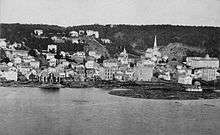
On July 29 and September 29, 1837, treaties were signed between the US government and the local Ojibwa and Dakota nations that allowed settlement in the St. Croix Valley. The town was founded by settlers drawn by the area's then-abundant lumber and river traffic, making it one of Minnesota's oldest towns, preceding Minneapolis by several years. Stillwater was officially incorporated as a city on March 4, 1854 (the same day as St. Paul).
Stillwater is often referred to as the birthplace of Minnesota.[10] In 1848, a territorial convention that began the process of establishing Minnesota as a state was held in Stillwater, at the corner of Myrtle and Main Streets. Minnesota officially became a territory in 1849 and a state in 1858.
As more evidence of Stillwater's importance at the time, the convention selected three leading Minnesota cities as locations for three important public institutions: Minneapolis got the University of Minnesota, Saint Paul became the capital, and Stillwater the site of the territory's first prison. The Minnesota Territorial Prison (later Minnesota State Prison) was opened in 1853. The prison held Cole, Jim, and Bob Younger, three of the Younger brothers of the James–Younger Gang
Lumbering was the predominant industry in the St. Croix River Valley in the second half of the 19th century, and for many years logs were sent down the St. Croix, collected at the St. Croix Boom Site two miles upstream of Stillwater, and processed in Stillwater's many sawmills. Steamboats were used most widely from 1860 to 1890, and a few are still used for entertainment today.
David Swain operated a shipyard and engine works in Stillwater. Excursion steamboats, such as the Verne Swain and the Capitol, appeared at the docks in the early 20th century.[11]
Stillwater sent men of the 1st Minnesota Volunteer Infantry Company B and the 8th Minnesota Volunteer Infantry Regiment Company C to fight during the American Civil War.[12][13]
On October 18, 1921, Charles Strite invented the automatic pop-up bread toaster in Stillwater. By 1926, the Toastmaster Company began to market the first household toaster using a redesigned version of Strite's.[14]
In 1996 the city of Stillwater entered into an agreement with Stillwater Township to annex land. In 2015 the Stillwater city council approved the annexing the last of the land covered by the agreement. The city's western border is now Manning Avenue (County Road 15). The northern border is now mostly, but not entirely, Minnesota Highway 96.[15]
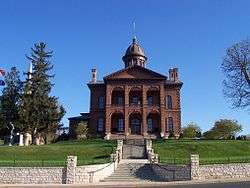
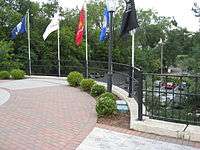 Across the street from the Courthouse, the Veterans' Memorial for local veterans
Across the street from the Courthouse, the Veterans' Memorial for local veterans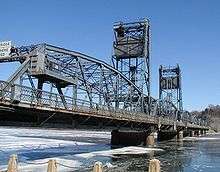 Lift Bridge
Lift Bridge
Demographics
| Historical population | |||
|---|---|---|---|
| Census | Pop. | %± | |
| 1860 | 2,380 | — | |
| 1870 | 4,124 | 73.3% | |
| 1880 | 9,055 | 119.6% | |
| 1890 | 11,260 | 24.4% | |
| 1900 | 12,818 | 13.8% | |
| 1910 | 10,198 | −20.4% | |
| 1920 | 7,735 | −24.2% | |
| 1930 | 7,173 | −7.3% | |
| 1940 | 7,013 | −2.2% | |
| 1950 | 7,674 | 9.4% | |
| 1960 | 8,310 | 8.3% | |
| 1970 | 10,191 | 22.6% | |
| 1980 | 12,290 | 20.6% | |
| 1990 | 13,882 | 13.0% | |
| 2000 | 15,143 | 9.1% | |
| 2010 | 18,225 | 20.4% | |
| Est. 2019 | 19,627 | [3] | 7.7% |
| U.S. Decennial Census[16] | |||
2010 census
As of the census[2] of 2010, there were 18,225 people, 7,075 households, and 4,885 families living in the city. The population density was 2,618.5 inhabitants per square mile (1,011.0/km2). There were 7,576 housing units at an average density of 1,088.5 per square mile (420.3/km2). The racial makeup of the city was 95.1% White, 1.0% African American, 0.4% Native American, 1.1% Asian, 0.6% from other races, and 1.8% from two or more races. Hispanic or Latino of any race were 1.9% of the population.
There were 7,075 households, of which 35.6% had children under the age of 18 living with them, 54.3% were married couples living together, 11.0% had a female householder with no husband present, 3.8% had a male householder with no wife present, and 31.0% were non-families. 25.5% of all households were made up of individuals, and 8.7% had someone living alone who was 65 years of age or older. The average household size was 2.51 and the average family size was 3.03.
The median age in the city was 40 years. 26.5% of residents were under the age of 18; 6.7% were between the ages of 18 and 24; 25.3% were from 25 to 44; 29% were from 45 to 64; and 12.8% were 65 years of age or older. The gender makeup of the city was 48.5% male and 51.5% female.
2000 census
As of the census of 2000, there were 15,143 people, 5,797 households, and 4,115 families living in the city. The population density was 2,340.0 people per square mile (903.7/km2). There were 5,926 housing units at an average density of 915.7 per square mile (353.6/km2). The racial makeup of the city was 94.0% White, 0.9% African American, 0.4% Native American, 1.1% Asian, 0.02% Pacific Islander, 0.1% from other races, and 1.6% from two or more races. Hispanic or Latino of any race were 1.9% of the population.
There were 5,797 households, out of which 36.8% had children under the age of 18 living with them, 57.2% were married couples living together, 10.8% had a female householder with no husband present, and 29.0% were non-families. 24.3% of all households were made up of individuals, and 9.0% had someone living alone who was 65 years of age or older. The average household size was 2.55 and the average family size was 3.07.
In the city, the population was spread out, with 27.7% under the age of 18, 6.3% from 18 to 24, 28.8% from 25 to 44, 25.4% from 45 to 64, and 11.8% who were 65 years of age or older. The median age was 38 years. For every 100 females, there were 92.9 males. For every 100 females age 18 and over, there were 86.7 males.
The median income for a household in the city was $57,154, and the median income for a family was $72,188. Males had a median income of $49,158 versus $33,680 for females. The per capita income for the city was $27,163. About 3.0% of families and 4.3% of the population were below the poverty line, including 5.6% of those under age 18 and 5.3% of those age 65 or over.
Education
Stillwater has a mix of public district, public charter, and private schools at the primary and secondary levels.
In the media
- In The Mighty Ducks films, one of the two "bash brothers", Fulton Reed (played by Elden Henson), is from Stillwater.
- The novel series The Emigrants and the musical Kristina från Duvemåla tell the story of a family of Swedish emigrants who journey to Minnesota in 1850. Much of the story takes place in Stillwater.
- In Juno, Bren MacGuff mentions purchasing an expensive womanly item at a Stillwater store.
- In the Supernatural episode "The Purge", Sam and Dean head to Stillwater when a competitive eater mysteriously dies in impossible circumstances.
- The entirety of the film The Unearthing takes place in Stillwater and the story revolves around a local ghost legend.
- In Fargo, Stillwater is mentioned, referring specifically to the prison.
- Many Corridor Digital YouTube videos were filmed in and around Stillwater.
Movies filmed entirely or partially in Stillwater
- Grumpy Old Men (1993)
- The Cure (1995)
- Grumpier Old Men (1995)
- Fargo (1996)
- Beautiful Girls (1996)
- Overnight Delivery (1998)
- Paperboys (2001)
- The Unearthing (2015)
Notable people
- Ed Ackerson, musician (Polara, The 27 Various) and record producer (The Jayhawks, The Replacements, Motion City Soundtrack), born and attended high school in Stillwater
- Brian Arnfelt, NFL defensive end, attended high school in Stillwater
- Michele Bachmann, U.S. Representative 2007–2015, lived in Stillwater
- Ben Blankenship, member of Team U.S.A. Track and Field who set the world record in the distance medley
- James B. Clark, director and Oscar-nominated film editor, was born in Stillwater
- Jessica Diggins, Olympic Gold Medalist, Cross-Country Skiing, attended high school in Stillwater
- Nate Dwyer, NFL linebacker, was born in Stillwater
- Chris Engler, NBA player, was born in Stillwater
- Sean Graham, retired professional track athlete and current head track and cross country coach at American University
- Phil Housley, Hockey Hall of Fame player and NHL coach, coached in Stillwater
- Todd Kalis, NFL guard, was born in Stillwater
- Jessica Lange, actress, resided in Stillwater
- Frankie Lee, musician, was born in Stillwater
- Jonah Marais, member of boyband Why Don't We
- Denis McDonough, White House Chief of Staff, was born in Stillwater
- Bob Nelson, NFL linebacker, was born in Stillwater
- Glen Perkins, pitcher for Minnesota Twins, was born in Stillwater
- Sam Shepard, playwright and actor, resided in Stillwater
- Rich Sommer, actor, was raised in Stillwater
- LaVyrle Spencer, a New York Times bestselling author, lived in Stillwater
- Alpheus Beede Stickney, a famous railroad builder, lived in Stillwater, born in Maine
- C. Gardner Sullivan, screenwriter and producer, was born in Stillwater
- Thomas Vanek, NHL winger for Buffalo Sabres and Minnesota Wild and others, resides in Stillwater
- Niko Pueringer, co-founder of Corridor Digital
See also
- Oak-Land Jr. High School
- Stillwater Area High School
References
- "2019 U.S. Gazetteer Files". United States Census Bureau. Retrieved July 26, 2020.
- "U.S. Census website". United States Census Bureau. Retrieved 2012-11-13.
- "Population and Housing Unit Estimates". United States Census Bureau. May 24, 2020. Retrieved May 27, 2020.
- "US Board on Geographic Names". United States Geological Survey. 2007-10-25. Retrieved 2008-01-31.
- "2010 Census Redistricting Data (Public Law 94-171) Summary File". American FactFinder. U.S. Census Bureau, 2010 Census. Retrieved 23 April 2011.
- "Find a County". National Association of Counties. Archived from the original on May 31, 2011. Retrieved 2011-06-07.
- "US Gazetteer files 2010". United States Census Bureau. Archived from the original on January 12, 2012. Retrieved 2012-11-13.
- Upham, Warren (1920). Minnesota Geographic Names: Their Origin and Historic Significance. Minnesota Historical Society. p. 571.
- Chicago and North Western Railway Company (1908). A History of the Origin of the Place Names Connected with the Chicago & North Western and Chicago, St. Paul, Minneapolis & Omaha Railways. p. 165.
- "The birth of Minnesota" (PDF). mnhs.org. 1997. Retrieved January 26, 2017.
- Brent T. Peterson. Stillwater. Charleston, SC: Arcadia Publishing. p. 80.
- From the Journal of Sgt. Sam Bloomer 1st Minnesota Volunteer Infantry Part I
- Historians seek Stillwater Civil War unit's flag
- "Patent for Bread-Toaster Issued October 18, 1921". www.uspto.gov. Archived from the original on February 1, 2015. Retrieved January 26, 2017.
- "Stillwater approves long anticipated annexation". Retrieved 13 Dec 2017.
- United States Census Bureau. "Census of Population and Housing". Retrieved June 9, 2014.
External links
| Wikimedia Commons has media related to Stillwater, Minnesota. |
| Wikivoyage has a travel guide for Stillwater. |
